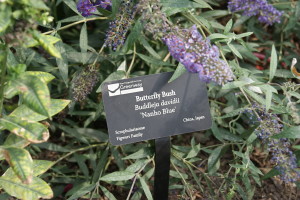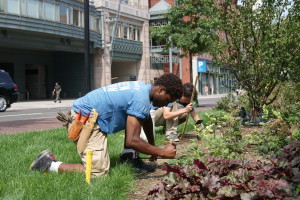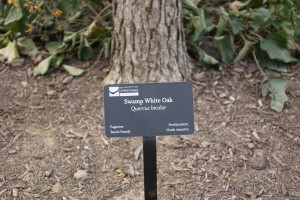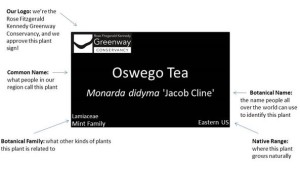
“What is this plant???” is a question our Horticultural staff hears daily. And we love telling you! We keep careful records of what is planted in our gardens, but we haven’t quite been able to share that wealth of knowledge with everyone yet. Whether you’re trying to find the perfect pink flower for your yard or you’ve never seen that gorgeous shrub with the dark feathery foliage, identifying our plants can be daunting.
We have over 700 unique species, cultivars, or hybrids of plants throughout our 15 acres of landscape, and with so many different kinds of plants it can be difficult to find their names.
We are thrilled to have added new plant signs in the Fort Point Channel Parks identifying the perennials, shrubs, and trees throughout the planting areas. These signs are the next generation of a pilot plant signage program in the Fort Point Channel Parks conducted by Massachusetts Horticultural Society volunteers five years ago as the parks first opened. We also replaced the existing signs that identified our two small apple trees from the Boston Tree Party in the Northern lawns of the Urban Arboretum. The new signs are made from black anodized aluminum that will not fade, rust, or corrode.

The plant signs are an easy way to educate our visitors about botanical classification, nomenclature, and plant nativity. Conservancy staff led the effort, with installation assistance this week from our hard-working Green & Grow summer interns.

We hope this is the beginning of an effort to place more signs throughout all of the parks, and to help acquaint our visitors with our collection of plants in new and unique ways.
What do our plant signs tell us?
Botanical Name: The botanical name is the accepted name that has been assigned to a plant after it has classified by taxonomists, it consists of at least two parts: the genus and specific epithet. Some organisms are further classified as subspecies, varieties, forms, cultivars, or hybrids beyond the species classification.
Common Name: the name that is often derived from typically-used language of our region, sometimes it is descriptive of the plant’s form, foliage, flower color, etc.
Botanical Family: a rank above Genus and Species in the classification of plants; plants that are grouped together in the same family are genetically, physiologically, morphologically, evolutionarily, or otherwise botanically similar
Native Range: this range defines the “eco-region” where this plant originated and grows naturally. We very rarely plant “annual” plants (i.e. plants that are not hardy to our eco-region), so any plant that is given a sign is indeed able to live in our tough New England climate, whether it’s native to the Northeast or to Asia!
How to read a plant sign:




